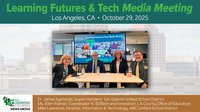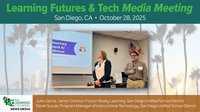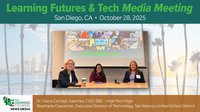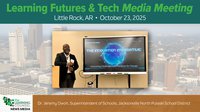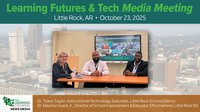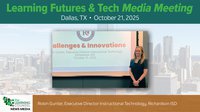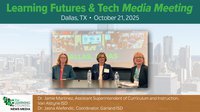Something much bigger is happening in America than leaders in education are even considering. It’s a vast shift awaiting a new structure to the form of schooling which is inhibited by old assumptions.
National trend patterns indicate that consumers are shopping for learning for their children that will fit them, not schools.
Schooling is out, learning is in.
If your mind is stuck in the 250-year-old pattern of kids leaving home and going to a school for a large portion of their day, you are making an assumption that this is necessary for your parent population because they work. This is no longer true – 35% of people are employed to work from home. Almost 70% of the tech industry work remotely and 91% worldwide prefer to work from home. True, many parents need to put their children in some form of childcare for the day, but is it traditional schooling? That is what they are questioning.
Let’s observe that commercial real estate everywhere in America has crashed. Out-migration from cities to suburbia and rural areas is the trend. Centralization to large single locations for companies is not the mode and yet, as districts have schools fail with mass attrition, they tend to centralize when perhaps the opposite would be wiser. A “retail outlet” that is walkable in neighborhoods might be the way to go.
Let’s also observe that community-creation is different. If people are going to get together, there needs to be a good enough reason to make that drive and take that time out of other aspects of living. Absenteeism rates suggest school is no longer a good enough reason.
It’s important to note that disengaged and absent-from-school youth are not just catatonically apathetic and anti-social – they are engaged elsewhere. That elsewhere is online with on-demand games and social interaction.
Meanwhile, educators fiddle with tweaking of what has always been the structure in schools. Some of those innovations are clues to where things will eventually arrive such as reducing the school week to four days and yet not saving 20% of cost, but only a measly .5% while now burdening parents with having to get childcare they thought their taxes were already paying for on the now-missing fifth day.
Another trend is the push to personalize learning for every student, since all of industry is customizing everything and delivering it within 24 hours and parental expectations are forcing school leaders’ hands to the point where teachers lament that “every child has an IEP.”
What are the old assumptions almost no school leader takes on to get to the real transformation necessary for this century?
1. Schools assume virtual learning doesn’t work or works extremely limitedly. Virtual learning has the reputation of largely being divorced from live teaching, which it does not need to be. During the pandemic, schools had most teachers holding online virtual classrooms using the lecture-style instruction and discussion they have always used in the same time schedule as always. There was very little shift in method because of the shift in mechanism. The assumption that screen learning or virtual-elsewhere learning doesn’t work is just not true. The science behind screen learning using quality digital crafting has many proofs.
2. Schools assume a linear master schedule, hour-after-hour by whole groups. They have apparently never considered how Uber works to auto-cohort drivers with riders with use of both time and space laterally on demand. Yet Time AI does exist now for schools in Knowstory.com.
3. Schools assume a teacher for each classroom each hour when “instructional minutes” are not defined as such in any State, and almost no teachers lecture or vocalize instruction the entire time. There could be a separation of the vocalized instruction and discussion versus the individual study of materials, breaking up and fractionalizing the typical class hour. This break up of teacher action versus independent student actions, a vast distinction in most subjects, would allow separation in space as well, freeing up the teacher to roam or manage time completely differently with smaller groups. At that point, the where of student study also becomes really flexible.
Such a simple thing – yet the ramifications would be enormous enough to avert the teacher shortage while providing a novel approach to flexibility learning consumers may not realize they always wanted but will when they are finally offered it.
4. Schools assume groupings by age in grades. This assumption that we are all the same at each age has never been strictly true for humanity, differing markedly for certain subjects even between males and females at different ages. To add insult to injury, assuming age patterns as the predominant model flies in the face of trying to create equity and diversity so many educators espouse.
5. Schools assume groupings are geographically local only, when individual students and teachers might be untethered from locality within a whole district or the whole State to form other, more logical groupings through remote technologies in other patterns of subject and ability. There is no reason that all local students interact only with other local students or that all their teachers are local. A mesh network pattern would only require districts and States effect a new sharing infrastructure of teaching and learner placement.
6. Schools assume this talk of time and space use would lead to all virtual teacher-less programs when that is just not the case. The problem starts at the constraints of the assumptions – not laws or unions or fear of technology. Technology can easily count “seat-time” for live or virtual teacher meetings plus study time. If it has to be study time on campus, provide homerooms with some oversight.
7. Statements like “educational software is just a tool,” “students can’t learn without a teacher,” and other overly general statements without inspection of what’s different now are examples that intellectually should be beneath our contempt. It is true that some students need the energy of fellow students working around them and learning facilitation by a teacher, but those dynamics could be purposeful in schooling rather than being a secondary condition of fully in-person schedules. In fact, teaching and learning methods that would offer learning punctuated by small group experiences students find motivating.
In summary, it is time education leaders took a step back and looked at the larger scene to think original thoughts about a future that clearly is trying to come to be, but that is being withheld from genesis.
With the attrition away from traditional education, meteoric increase in homeschooling, and perfect storm of problems as the disaggregation is accelerating – leaders that stand with the past won’t be leading for long.
Write to me if you’ve had an idea to share or want to discuss.




